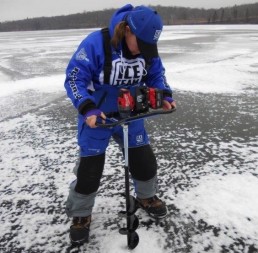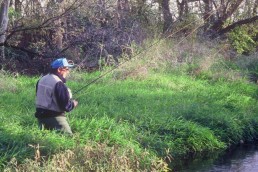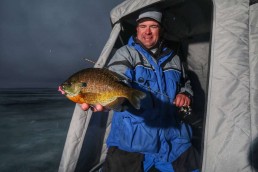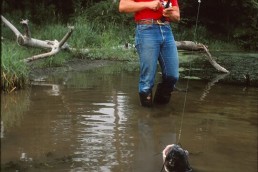The Trend Toward Smaller Holes, Lighter Augers
SHARE THIS POST
I’m enjoying seeing my daughters out on the ice. The gas-powered augers are too big and heavy for them and they can’t completely control them or drill a straight hole with one. But I never realized that they didn’t drill their own holes. However, they are troopers and check all the open holes around the hot spot, hoping to find a fish. They’ll wait impatiently for someone “bigger” to drill them another hole so they can look more. Honestly, on one day I was nearby with them I wasn’t just going to stop catching fish where I was to drill holes for them. So, they ended up waiting until the bite stopped or until someone just got tired of catching fish.
With the introduction of lithium-powered battery drills connected to a 6-inch auger bit they now have the ability to drill their own holes—many. They are now out there looking for better fishing spots. I have even noticed this trend out on the ice, with more youngsters and women enjoying ice fishing. There are quite a few ice fishermen out there thinking that a 6-inch hole is worthless and that their fish would never fit up that small of an opening.
Bigger holes do have their place in ice fishing, but many apparently don’t understand that bigger isn’t always better.
The advantages of the smaller hole
The smaller the auger bit, the easier it is to drill a hole. And, smaller augers are lighter, making them easier to carry out onto the ice. With smaller holes, there is generally less skimming of slush to clear out a hole too, so you can start fishing sooner.
When it is “easy,” you will drill more holes, so when you drill more it means you are moving more. And more holes equals more fish because you are covering more water. Drilling one and sitting over the top of it, waiting for the fish to find you is still one of the big mistakes. Again, smaller holes can often lead to more success than the larger ones, and there is evidence. Fish, especially larger species, can get hole-shy.
Are you enjoying this post?
You can be among the first to get the latest info on where to go, what to use and how to use it!
The stories you hear from the spear fisherman about how the bigger fish won’t come into a hole are largely true. The best spear fishermen work harder to get their house extra dark, so no light spills into the hole. The smaller holes don’t let nearly as much light into the water as the bigger ones do. This is especially important in clear, shallow water. On bright days or anytime we’re fishing inside our Fish Traps, we often leave slush in the hole trying to keep the light from going down the hole.
Do you really need the big hole?
Stories fly around about how so-and-so hooked a big fish and how it wouldn’t come up a hole. They’ll add they had to try and make the hole bigger to land the fish. These stories are often fairy tales. Once a fish gets started up a smaller hole it tends to swim straight toward you; it can’t turn around to go back down. But big bluegills, crappies and perch do try to turn around in an 8-inch hole or larger, even after you’ve started them up inside the hole. When this happens, it can become a nightmare as tangling in the transducer cord or losing a fish can occur. I’ve seen 10-pound walleyes come popping right up a 6-inch hole on light line. My good friend Mike Nowak landed a 9-pound, 6-ounce walleye on 4-pound-test line. He led it right up a 6-inch hole. I’ve landed 2-pound crappies and 1-pound bluegills through a 6-inch hole and have watched fellow Ice Team Pro Rick Johnson pull 1-pound bluegills and a 4 1/2-pound bass through a 5-inch hole. So I’ve watched people land large fish through a smaller hole every winter, so nobody can tell me it can’t be done.
When I see a large fish lying out on the ice I sometime think to myself: It must have been an optical illusion. But when they’re returned to the water they can fit back through that same hole you caught them through.
Equipment choice
Years ago, when I was helping my dad take people ice fishing in northern Minnesota, he taught me to be aggressive and drill a lot of holes. Back then we didn’t have many choices: we either used a 6-inch spoon auger or chopped the hole with an ice chisel. Trust me, you didn’t chop too many holes through midwinter ice. We did though manage to catch lots of big walleyes and northern pike out of those 6-inch holes. These days, I mainly drill a 6-inch hole and have my Milwaukee 18-volt and DeWalt 20-volt drills attached to a Clam Ice Auger Conversion Plate with a Vexilar K-Drill so it’s almost effortless. There are times though when a larger hole is nice, such as when you’re sight fishing big lake trout in shallower water. I’ll attach a conversion kit to drill a 9-inch hole with a lithium-powered drill.
There are many advantages to using lighter augers to drill multiple smaller holes. And, today my girls are better equipped to go off and find their own fish.
MWO
SHARE THIS POST
Did you enjoy this post?
You can be among the first to get the latest info on where to go, what to use and how to use it!
Dave Genz
Dave Genz, known as Mr. Ice Fishing, was the primary driver of the modern ice fishing revolution. He has been enshrined in the National Fresh Water Fishing Hall of Fame and Minnesota Fishing Hall of Fame for his contributions to the sport. For more fishing tips and to order his new info-packed book, Ice Revolution, go to davegenz.com.



